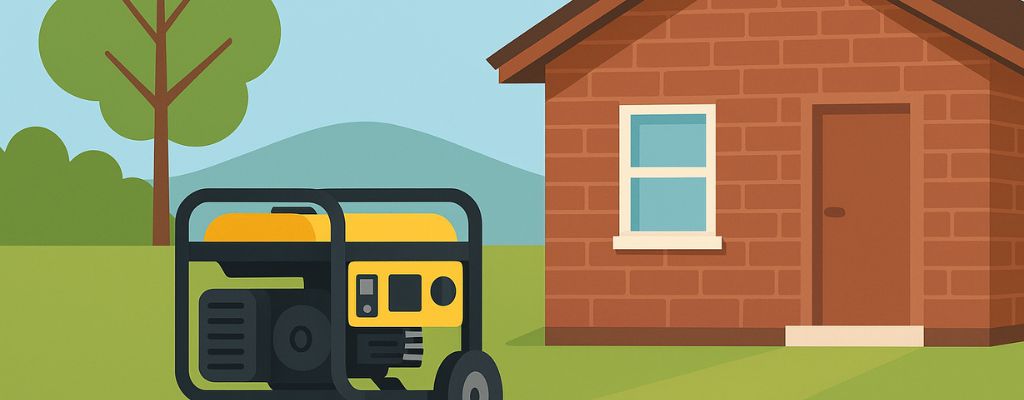
How Far Should a Generator Be From a House?
So, how far should a generator be from your house? At least 6 metres! Generators can be lifesavers, but they come with risks—carbon monoxide and fire hazards are the big ones. Keep reading to learn why placing your generator just right is key to keeping your home safe and your generator running smoothly.

Critical Safety Distances for Your Generator: Preventing Hazards and Meeting Requirements
When positioning your generator, safety is the number one priority. The right distance not only ensures the generator performs at its best but also helps prevent dangers like carbon monoxide poisoning and fire hazards.
Carbon Monoxide (CO) Poisoning: The Primary Concern for Your Generator's Placement
One of the most significant dangers of improper generator placement is carbon monoxide (CO). This deadly gas is colourless and odourless, which makes it even more dangerous. A generator positioned too close to your house can release CO into your home, putting everyone at risk.
The Invisible Danger: How CO from Your Generator Can Enter Your Home
Even though CO is invisible and undetectable by smell, it can easily find its way inside. If your generator is too close to windows, doors, or vents, the exhaust gases can be sucked into the home, potentially leading to poisoning.
The Critical Minimum: How Far Must a Generator Be From the House to Prevent CO Buildup?
To prevent this deadly risk, Australian safety standards, such as AS/NZS 3010:2005, recommend placing your generator at least 6 metres away from the house. This ensures any CO released is far enough from your living spaces to keep everyone safe.
Fire Hazards: Protecting Your Home from Your Generator's Operation
Generators can pose fire risks, especially in dry conditions or when they’re placed near flammable materials. It’s essential to make sure your generator is positioned far enough away to avoid any potential fire hazards.
Combustible Materials and Flammable Fuels Near Your Generator's Heat
Generators can generate a lot of heat. If they’re placed near combustible materials like dry leaves or stored fuel, there’s a risk of ignition. Always make sure to keep the area around the generator clear to prevent any fires from starting.
Maintaining Adequate Clearance Around Your Generator for Heat Dissipation from All Sides
Another crucial factor is ensuring the generator has enough space around it for heat to dissipate. Without this, the generator could overheat, causing damage or even fire. Keep the area around your generator open and free from obstructions.

Specific Placement Considerations for Your Portable and Standby Generator
Whether you’re using a portable generator for short-term power or a larger standby generator for longer-term use, proper placement is key to both safety and performance. Let’s break it down.
How Far Should a Portable Generator Be From the House? Guidelines for Temporary Power
Portable generators, typically used for short-term power needs, should also be placed at least 6 metres away from your house. This precaution protects you from CO poisoning and ensures your generator operates safely.
Why Portable Generator Placement Requires Vigilance Even for Short-Term Use
While you may think a portable generator is just for temporary use, even short-term setups require serious consideration. These generators can still emit harmful gases and heat, making it crucial to follow placement guidelines no matter how brief the power outage.
Factors Unique to Portable Generators Influencing Safe Distances from Your House
Factors such as wind direction, proximity to windows or doors, and local environmental conditions should all be considered when placing a portable generator. Wind can blow exhaust fumes closer to your house, while extreme weather could exacerbate fire risks.
How Far Should a Generator Be From a Window, Door, or Vent? Avoiding Ingress Points
It’s not just about distance from the house—think about placement relative to windows, doors, and vents.
Preventing Exhaust Fumes from Entering Your Home Through Openings Near Your Generator
If your generator is too close to these openings, exhaust fumes can easily be sucked inside. This is especially dangerous when the wind shifts, so make sure your generator is positioned far enough away to avoid this risk.
The Importance of Proper Ventilation for Your Generator in Relation to Building Features
Ensure your generator is in a well-ventilated area with no obstructions that could cause exhaust gases to linger around the building. Proper airflow keeps the generator cool and prevents harmful gases from accumulating.
Where to Put Generator During Storm: Balancing Safety with Practicality
When storms hit, the placement of your generator can be tricky. You need to consider both safety and practicality, especially if you want the generator to run during severe weather conditions.
Elevated Placement to Avoid Floodwaters While Maintaining Safe Distances for Your Generator
Place your generator on a raised surface to avoid floodwaters, but also ensure it’s still at a safe distance from the house to avoid CO and fire risks.
Ensuring Accessibility for Refueling and Operation of Your Generator During Inclement Weather
While you may want to keep your generator safe from storms, don’t forget that you’ll need easy access for refueling and maintenance. Consider positioning the generator somewhere sheltered yet accessible during severe weather.

Regulatory Compliance and Community Insights for Your Generator Placement
Compliance with local laws ensures both safety and peace of mind when installing your generator. Let’s dive into the rules and regulations, as well as insights from the community.
Generator Distance From House Code: Understanding Local Laws and Standards
Each region has its own set of guidelines, but Australia’s regulations are clear on safe generator distances. Familiarising yourself with these will ensure your setup complies with local standards.
Adhering to National Electrical Code (NEC) and Local Building Regulations for Your Generator
In Australia, following national electrical codes and local regulations is essential. These laws not only prevent accidents but can also protect you from hefty fines.
Obtaining Necessary Permits and Inspections for Your Generator Installation
In some areas, you’ll need a permit or inspection for installing a generator. Be sure to check with local authorities to make sure you’ve followed all legal steps.
Is Generator 10 Feet From House Enough? Assessing Common Recommendations
The commonly quoted 10-foot rule is often a minimum, but the Australian standards usually recommend more space for safety.
The "20-Foot Rule" and Why It's Often the Safest Minimum for Your Generator
The "20-foot rule" takes into account factors such as the size of the generator, its exhaust output, and weather conditions. In some cases, a 6-metre (approximately 20 feet) distance is the safest option for ensuring CO and fire hazards are minimised.
Situational Factors That Might Require Greater Distances for Your Generator
Depending on the generator’s power output and your property’s layout, you may need to place your generator even further from the house. Always check manufacturer guidelines and consult experts if unsure.
How Far Should a Generator Be From a House Reddit? Community Discussions and Experiences
Online communities can offer valuable insights when determining safe distances for your generator placement.
Real-World Advice and Shared Challenges from Other Generator Owners
Real-world advice from other generator owners on Reddit can help you troubleshoot common problems and share lessons learned from their experiences.
Learning from Practical Scenarios on Generator Placement from Online Communities
Reading through shared experiences helps you avoid the mistakes others have made and can give you new ideas for better positioning your generator.
Conclusion: Balancing Safety, Compliance, and Practicality for Your Generator Placement
Properly positioning your generator is not just a matter of convenience—it’s about safety and compliance. By following safety guidelines, considering weather factors, and adhering to local regulations, you’ll ensure that your generator performs reliably while keeping your home and family safe. Always check the manufacturer’s instructions and consult local laws to avoid potential hazards.


